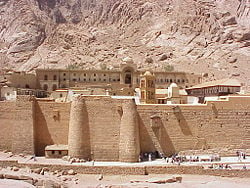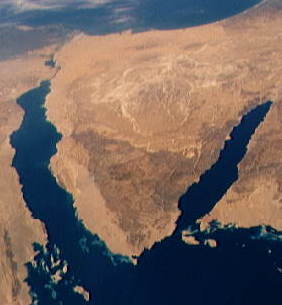Sinai Peninsula
The Sinai Peninsula is a triangle-shaped peninsula lying between the Mediterranean Sea (to the north) and Red Sea (to the south), located in Egypt and has an area of about 60,000 square kilometers. Its land borders are the Suez Canal to the west and the Israeli-Egypt]]ian border to the north-east. The Sinai Peninsula is in Southwest Asia (also called West Asia - the more geographically accurate term for the Western term [esp. American usage] of Middle East) while the rest of Egypt is in North Africa. For geopolitical purposes, the Sinai is often considered part of Africa (as the rest of Egypt is).
The Sinai is almost entirely desert, but is settled along the Sabah coast at Taba (near the Israeli town of Eilat), where there is a hotel and casino. Moving southwards along the coast, there lie: Nuweiba, Dahab and Sharm el-Sheikh. The Sinai is also settled on the north coast near the Gaza Strip at El-Arish. Bedoins carry on their pastoral herding lifestyle in the bordering desert areas and some live in stationary homes in outlying towns and cities near more populated areas.
Mount Sinai in the Sinai is biblically significant as it is allegedly the site where Moses received the Ten Commandments. A monastery situated at St. Catherine in the southern Sinai Peninsula claims to be at the site of Mount Sinai, though historians and archeologists generally reject this as the site. Jebel Musa is the name of this site or holy mountain.
The eastern boundary of the peninsula is a geological fault zone known as the Great Rift Valley, which can be seen from the upper Jordan River valley, extending southward through the Red Sea into Africa.
History
The desert of the Sinai is a land that holds fascination particularly for those interested in some of the oldest Bibical civilization stories. The great patriarchs of bibical history, Abraham, Moses and others all lived or passed through here at one time. The story of the Exodus (about 1250 B.C.E.) of the Hebrew peoples led by Moses out of Egypt to wander 40 years in the desert land is one of the more unforgettable stories of this great desert. Ever since the earliest Christian pilgrims came here in search of the holy mountain where Moses met God, shrines, monastaries, mosques and other holy places have been erected in this desert wilderness for all in search of spiritual enlightenment, purification and inner peace. Some journey to this isolated region looking to connect with ancient spritual foundations, wisdom and insight or, in the case of modern archeologists, evidence to give physical proof to the bibical stories.
Around 250 C.E. the Roman emporer Justinian commissioned the Monastary of St. Catherine to be built at the foot of what is thought to be Mt. Horab from the bibical story of Exodus. This mountain today is called Mt. Sinai or Jeba Musa. The monastery has survived many groups of desert marauders over the past 1500 years. Muslims left this landmark intact even during the Crusades because it honors one of Islam's most important prophets, Moses. Third century hermits sought refuge and seclusion in the hights of the mountains around St. Catherine's monastry.
There are many archeological sites in this desert such as nawamis, roofed rooms which are thought to have been burial chambers belonging to prehistoric peoples. The Nabateans who inhabited this desert in the 2nd and 3rd centuries left behind one of the most beautiful reminders of ancient peoples who used to live here. These are the ornate carved rose-colored rock facades of the city of Petra.
The Sinai was inhabited by the Monitu and was called Mafkat or Country of Turquoise. From the time of the First dynasty or before, the Egyptians mined turquoise in Sinai at two locations, Wadi Maghareh and Serabit el-Khadim. They were operated on and off on a seasonal basis for thousands of years. Modern attempts to exploit the deposits have been unprofitable. These may be the first known mines.
In 1844 the Codex Sinaiticus, one of the oldest manuscripts of the New Testament was found near St. Catherines.
Modern history
Until the early 20th century, Sinai was under the control of the Ottoman Empire. In 1906 it became part of then British-controlled Egypt, when the Turkish government yielded to British pressure to hand over the peninsula. The border imposed by the British runs in an almost straight line from Rafah on the Mediterranean shore to Taba on the Gulf of Aqaba. This line served as the eastern border of Sinai ever since, and is now the international border between Israel and Egypt.
In 1948, Egyptian forces passed through Sinai on their way to invade the newly-created state of Israel based on a United Nations mandate dividing the land between the Jews and the Christian and Muslim inhabitants. During the 1948 Arab-Israeli War, Israeli forces entered the north-eastern corner of Sinai, but withdrew shortly after, following British and American pressure. Under the terms of the 1949 Armistice Agreement, Sinai, together with the Gaza Strip, remained under Egyptian control, although parts of it were demilitarized.
In 1956, Egypt used its control of Sinai to impose a blockade on the Israeli port of Eilat. Following this, Israeli forces, aided by Britain and France (which sought to regain control over the Suez Canal) invaded Sinai, and took control over the entire peninsula within several days (see Suez Crisis). Several months later, Israel withdrew its forces from Sinai, following strong American and Russian pressure. Following this, the United Nations Emergency Force, the UNEF, was stationed in Sinai to prevent any military occupation of the Sinai.
In 1967, Egypt reinforced its military presence in Sinai, renewed the blockade on Eilat, and on May 16 ordered the UNEF out of Sinai effective immediately. In the following Six-Day War, the Egyptian army was defeated, and Israel took control over the entire peninsula. The Suez Canal, whose east bank was now controlled by Israel, was closed.
In the 1973 Yom Kippur War, Egyptian forces built pontoon bridges to cross the Suez Canal and stormed the supposedly impregnable Barlev Line to gain control of most of the Eastern Bank. Some held positions and others were pushed back across the Suez Canal, the war ending with some of each side's forces on both sides of the canal. As part of the subsequent Sinai Disengagement Agreements, Israel withdrew from west of the canal and pulled out of an additional strip in the western Sinai — while Egyptians held positions in Sinai — allowing for the later re-opening of the canal eventually under Egyptian control.
In 1979 Israel and Egypt signed a Peace Treaty, in which Israel agreed to transfer all control over Sinai to Egypt. Subsequently, Israel pulled out of Sinai in several stages, ending in 1982. The Israeli pull-out involved the destruction of several Israeli settlements including the town of Yamit in north-eastern Sinai.
Present

.
The Sinai Peninsula is currently divided among several governorates, or provinces, of Egyptian administration. The southern portion of the Sinai is called Janub Sina' in Arabic, literally "Sinai South." The northern portion is named Shamal Sina', or "Sinai North." the other three governates converge on the Suez Canal, including Al Isma'iliyah on its southern end and crosses into Egypt-proper. In the center is As Suways, literally "the Suez;" and Bur Sa'id lies in the north with its capital at Port Said.
Approximately 66,500 live in Janub Sina' and 314,000 live in Shamal Sina'. Port Said itself has a population of roughly 500,000, while the rest of the governorate (Bur Sa'id) itself. Portions of the populations of Al Isma'iliyah and As Suways live in Sinai, while the rest live on the western side of the Suez Canal in Egypt proper. The combined population of these two governorates is roughly 1.3 million (only a part of that population live in the Sinai, while the rest live on the western side of the Suez).
Other References
The Israelites made one of their camps during the Exodus in an unspecified part of the Sinai desert.
External links
- Wikitravel: Sinai
- The History of the Ancient Near East
- Geographia: Sinai
- Map of the Sinai
- [http://www.world-gazetteer.com/wg.php?
Credits
New World Encyclopedia writers and editors rewrote and completed the Wikipedia article in accordance with New World Encyclopedia standards. This article abides by terms of the Creative Commons CC-by-sa 3.0 License (CC-by-sa), which may be used and disseminated with proper attribution. Credit is due under the terms of this license that can reference both the New World Encyclopedia contributors and the selfless volunteer contributors of the Wikimedia Foundation. To cite this article click here for a list of acceptable citing formats.The history of earlier contributions by wikipedians is accessible to researchers here:
The history of this article since it was imported to New World Encyclopedia:
Note: Some restrictions may apply to use of individual images which are separately licensed.
